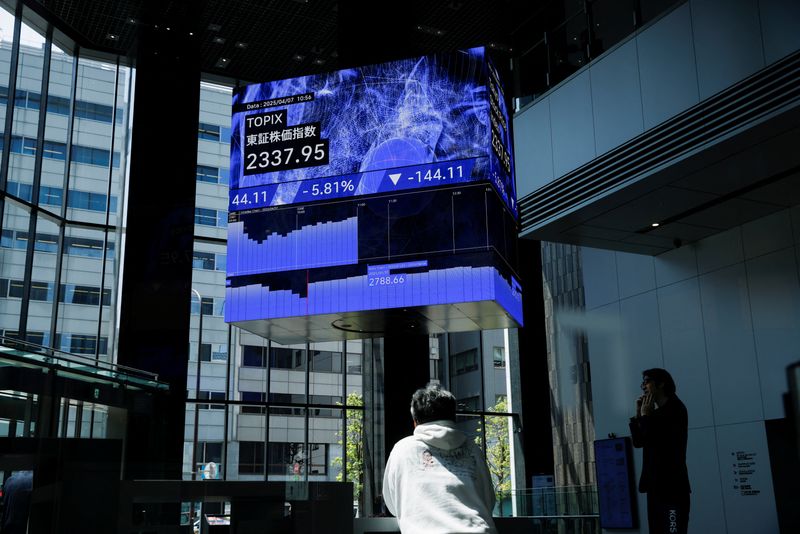Asian stock markets experienced volatility on Tuesday as investors grappled with the implications of the latest U.S. tariffs and an uncertain trajectory for American interest rates. The financial landscape remains tense as President Donald Trump’s trade policies continue to exert pressure on global markets, with the U.S. dollar also showing signs of weakness.
Markets across Asia showed mixed results, with Japan’s Nikkei 225 index closing slightly higher, while Hong Kong’s Hang Seng index slipped. The Shanghai Composite Index also saw marginal declines, reflecting investor caution in the face of ongoing economic uncertainty.
Impact of U.S. Tariffs on Global Markets
The announcement of new tariffs by the Trump administration has sent ripples through the global economy. These tariffs, aimed primarily at China, have raised concerns about the potential for a prolonged trade war that could stifle economic growth worldwide. Asian economies, heavily reliant on exports, are particularly vulnerable to these developments.
According to market analysts, the tariffs could lead to increased costs for businesses and consumers alike, potentially dampening demand and slowing economic activity. “The ripple effects of these tariffs are being felt across the globe,” said James Wong, a senior economist at HSBC. “Asian markets are especially sensitive given their export-driven nature.”
The U.S. Dollar’s Fragility
Meanwhile, the U.S. dollar has shown signs of frailty, adding another layer of complexity to the current economic climate. The dollar index, which measures the currency against a basket of others, has been on a downward trend, reflecting investor uncertainty about the Federal Reserve’s future interest rate decisions.
The Federal Reserve’s stance on interest rates remains a critical factor for global markets. While some analysts predict a more dovish approach in the wake of slowing economic indicators, others believe that inflationary pressures could prompt the Fed to maintain a tighter monetary policy.
“The dollar’s weakness is a double-edged sword for Asian markets,” noted Sarah Lee, a currency strategist at Morgan Stanley. “While it can make Asian exports more competitive, it also signals underlying economic concerns.”
Historical Context and Expert Opinions
This situation is reminiscent of previous trade tensions between major economies. Historically, trade disputes have led to market instability and economic slowdowns. The current scenario is no different, with experts drawing parallels to past episodes of economic uncertainty.
Dr. Emily Chen, a professor of international economics at the University of Tokyo, highlighted the potential long-term impacts of the ongoing trade tensions. “If history is any guide, prolonged trade disputes can lead to more entrenched economic challenges,” she explained. “It is crucial for policymakers to find common ground to avoid a protracted economic downturn.”
Looking Ahead: Potential Outcomes and Strategies
As the situation unfolds, investors and policymakers alike are closely monitoring developments. The potential outcomes are varied, with some experts suggesting that a resolution to the trade disputes could stabilize markets, while others warn of the possibility of further volatility.
In the short term, market participants are likely to remain cautious, seeking to mitigate risks through diversified investment strategies. Governments in the region may also consider implementing measures to bolster economic resilience, such as fiscal stimulus or monetary easing.
The coming weeks will be critical in determining the trajectory of Asian markets and the global economy. As negotiations continue and economic data is released, stakeholders will need to navigate a complex landscape, balancing risks and opportunities in an increasingly interconnected world.
The developments in Asian markets serve as a reminder of the intricate web of global economic ties and the far-reaching implications of policy decisions. As the situation evolves, the world will be watching closely, eager for signs of stability and growth.
About The Author
 Jeff Bezos Sells $737 Million in Amazon Stock Amid Lavish Wedding Celebration
Jeff Bezos Sells $737 Million in Amazon Stock Amid Lavish Wedding Celebration Bryan Kohberger Plea Deal Sparks Controversy Among Victims’ Families
Bryan Kohberger Plea Deal Sparks Controversy Among Victims’ Families US Halts Some Munitions Shipments to Ukraine Amid Defense Review
US Halts Some Munitions Shipments to Ukraine Amid Defense Review Mastering Stealth in Death Stranding 2: A Comprehensive Guide
Mastering Stealth in Death Stranding 2: A Comprehensive Guide Federal Judge Halts Early Termination of TPS for Haitian Migrants
Federal Judge Halts Early Termination of TPS for Haitian Migrants